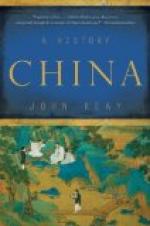Like all Turkish peoples, the Toba possessed a myth according to which their ancestors came into the world from a sacred grotto. The Buddhists took advantage of this conception to construct, with money from the emperor, the vast and famous cave-temple of Yuen-kang, in northern Shansi. If we come from the bare plains into the green river valley, we may see to this day hundreds of caves cut out of the steep cliffs of the river bank. Here monks lived in their cells, worshipping the deities of whom they had thousands of busts and reliefs sculptured in stone, some of more than life-size, some diminutive. The majestic impression made today by the figures does not correspond to their original effect, for they were covered with a layer of coloured stucco.
We know only few names of the artists and craftsmen who made these objects. Probably some at least were foreigners from Turkestan, for in spite of the predominantly Chinese character of these sculptures, some of them are reminiscent of works in Turkestan and even in the Near East. In the past the influences of the Near East on the Far East—influences traced back in the last resort to Greece—were greatly exaggerated; it was believed that Greek art, carried through Alexander’s campaign as far as the present Afghanistan, degenerated there in the hands of Indian imitators (the so-called Gandhara art) and ultimately passed on in more and more distorted forms through Turkestan to China. Actually, however, some eight hundred years lay between Alexander’s campaign and the Toba period sculptures at Yuen-kang and, owing to the different cultural development, the contents of the Greek and the Toba-period art were entirely different. We may say, therefore, that suggestions came from the centre of the Greco-Bactrian culture (in the present Afghanistan) and were worked out by the Toba artists; old forms were filled with a new content, and the elements in the reliefs of Yuen-kang that seem to us to be non-Chinese were the result of this synthesis of Western inspiration and Turkish initiative. It is interesting to observe that all steppe rulers showed special interest in sculpture and, as a rule, in architecture; after the Toba period, sculpture flourished in China in the T’ang period, the period of strong cultural influence from Turkish peoples, and there was a further advance of sculpture and of the cave-dwellers’ worship in the period of the “Five Dynasties” (906-960; three of these dynasties were Turkish) and in the Mongol period.
But not all Buddhists joined the “Church”, just as not all Taoists had joined the Church of Chang Ling’s Taoism. Some Buddhists remained in the small towns and villages and suffered oppression from the central Church. These village Buddhist monks soon became instigators of a considerable series of attempts at revolution. Their Buddhism was of the so-called “Maitreya school”, which promised the appearance on earth of a new Buddha who would do away with all suffering and introduce a Golden




